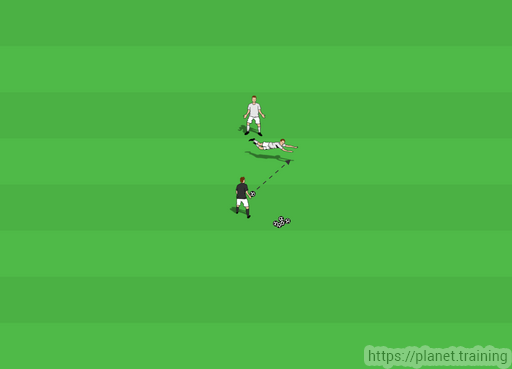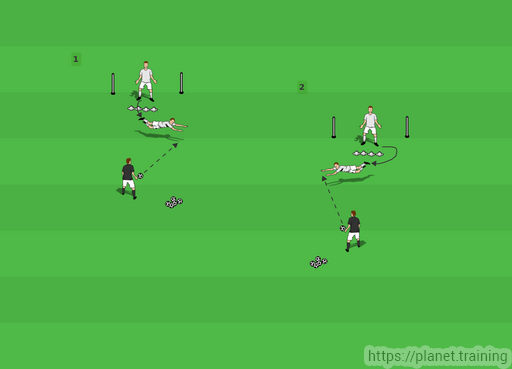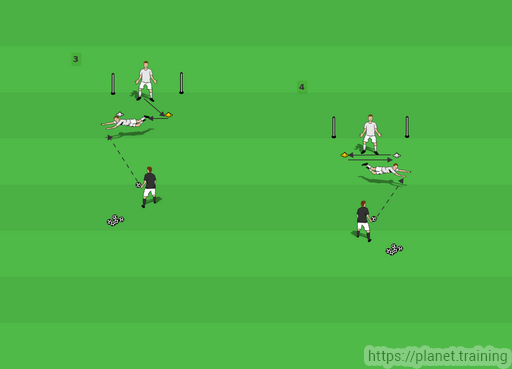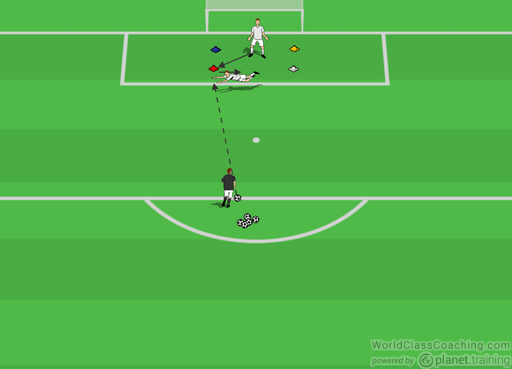By Scott Housden -
The dive, it appears is the most attractive aspect of goalkeeping – particularly for junior goalkeepers, and is the skill which gives most satisfaction when performed correctly. Every goalkeepers diving proficiency differs from side to side (with a preference to one side). These drills below will help harmonise this diving technique and maximise their diving efficiency. These drills can be used for goalkeepers of all abilities from juniors through to seniors.
Set Up
• Goalkeeper starts on their knees with the server holding a ball out to one side of the goalkeeper (slightly forwards).
• The goalkeeper then moves forward in a diving action to take the ball from the server, taking it to the ground.
• The goalkeeper returns the ball and repeats on the other side from a kneeling position.
• Perform 4-6 repetitions either side.
• This drill is then repeated with the goalkeeper in a standing set position.
• From here, the server then moves back and repeats the drill but this time they underarm throw the ball at knee to waist height to alternating sides to the goalkeeper.

Coaching Points
Working on perfecting diving technique on a regular basis will stand any goalkeeper in good stead for games.
• Ensure of a good ‘set’ position with hands active.
• Always use the leg nearest the ball when stepping into the save on a slight angle towards the ball, taking a small step.
• Leading with the hands moving towards the ball, the goalkeeper’s body weight will shift to the nearest leg moving towards the ball. This, the goalkeeper uses to drive towards the ball.
• Lead the dive with both hands and attack the ball as early as possible, diving across and forwards (on an angle).
• This technique gives direction with the goalkeeper’s knee moving over their foot and their shoulder moving over their knee.
• The goalkeeper should land in order of knee, hip, shoulder and lastly the ball in a controlled manner, landing on their side.
Progression 1
The drill moves into a small goal with a row of cones just in front of the goal, with the goalkeeper performing minor tasks prior to making a foot knee shoulder diving save.
• The goalkeeper jumps over the row of cones with the server underarm throwing the ball at knee to waist height to a nominated side when the goalkeeper ‘sets’. Repeat 4-6 times each side.
• The goalkeeper moves around the row of cones, setting in front with the server then throwing the ball at knee to waist height to a nominated side. Repeat 4-6 times each side.

Coaching Points
Emphasis throughout these drills has to be on the goalkeeper’s diving shape as outlined in the Coaching Points above.
• Remember. The goalkeeper must dive forwards on an angle towards the ball.
• The front leg is bent with the upper body weight over the leg assisting the stability of the dive (or the drive towards the ball for an extended save)
• The goalkeeper grasps the ball with their arms outstretched (to allow the goalkeeper to cushion the ball by bending their arms slightly to take the pace out of the ball).
Progression 2

Here the goalkeeper does not know which side the ball is going to be thrown to and so a strong balanced ‘set’ position is vital.
• The goalkeeper moves and touches a coloured cone nominated by the server and then moves and ‘sets’ in line with the ball.
• The server then underarm throws the ball at knee to waist height to either side (at the server’s discretion). Repeat 4-6 times each side.
• The goalkeeper continually moves laterally between the cones.
• The server then underarm throws the ball at knee to waist height to either side (at the server’s discretion). Repeat 4-6 times each side.
Progression 3

This final progression simulates initial movement by the goalkeeper in having to deal with a ball that has been centered.
• The goalkeeper starts centrally and the server nominates a colour for the goalkeeper to move to and touch.
• The goalkeeper then levels off and moves in line with the ball. The server then shoots at their discretion (aiming to keep the ball at waist height or lower).
• Further progressions include the server nominating two colours for the goalkeeper to move and touch prior to making a save. Secondly, after the goalkeeper makes their first save, the server nominates another colour that the goalkeeper must recover and move to and touch before moving in line to make a second save
Coaching Points
• Emphasise the small angled step towards the ball.
• Leading with your hands to encourage your upper body drive.
• Pushing off the front foot to encourage a lower body drive.
• Outstretched arms when catching the ball (to allow the goalkeeper to cushion the ball by bending their arms slightly to take the pace out of the ball).
By Scott Housden
Scott is both a UEFA ‘B’ and UEFA ‘B’ Goalkeeping Coach and holds a Masters in Sports Management. He has been a goalkeeper coach in professional football in the UK and Australia at First Team, Academy and Women’s levels. He currently runs a Goalkeeper Academy in the Western Suburbs of Brisbane, Australia.


